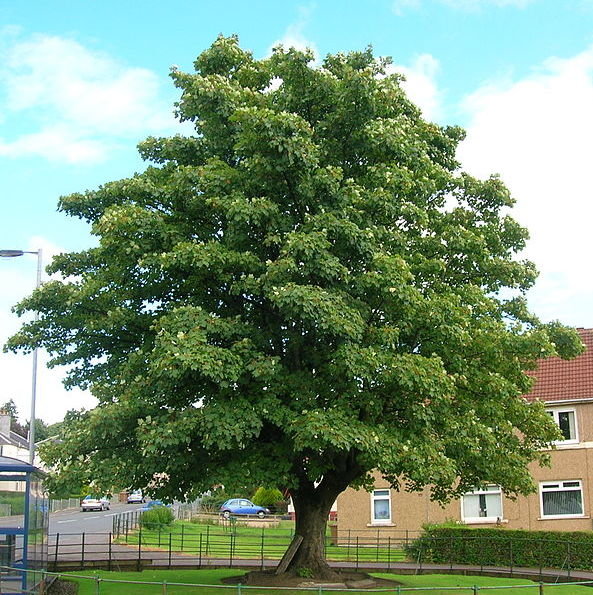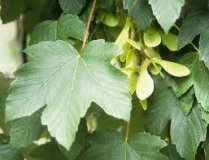- Home
- >
- Broadleaved Tree Seeds A-I by Latin Name
- >
- Sycamore (acer pseudoplatanus)
Sycamore (acer pseudoplatanus)
SKU:
£1.25
1.25
8.5
£1.25 - £8.50
Unavailable
per item
Seed Prices
5 grams (approx 35 seeds) £1.25
10 grams (approx 70 seeds) £1.80
25 grams (approx 175 seeds) £3.00
50 grams (approx 350 seeds) £4.75
100 grams (approx 700 seeds) £8.50
Although these seeds are from a good source they are not approved for forestry use
Use the drop down button below to select the quantity
The Sycamore is native to central Europe and south western Asia, from France east to Ukraine, and south in mountains to northern Spain, northern Turkey, and the Caucasus. It is a large deciduous tree that reaches 20–35m tall at maturity, with a broad, domed crown.
It is hardy to zone 5 −28.9 °C (−20 °F). It produces yellow-green flowers on 10–20 cm pendulous racemes containing 20–50 flowers between from Apr to June, filled with abundant nectar, which makes a fragrant, delicately flavoured and pale-coloured honey. The helicopter like seeds ripen in the early autumn. These rotate when they fall and this helps them to spread further from the parent tree.
Suitable for a wide range of soil types from light and sandy to heavy clay and even nutritionally poor soils. Their best development is on well-drained soil, they are not fussy as to soil pH and many superb specimens such as the one above can be found growing on the limestone soils of the Yorkshire Dales in the U.K. It can grow in semi-shade in light woodland or in full sun and is noted for its tolerance of wind, urban pollution and salt spray, which makes it a popular tree for planting in cities, along roads treated with salt in winter, and in coastal localities.
The sap contains sugar and can be used as a drink or be concentrated into a syrup by boiling off the water. The syrup is used as a sweetener on many foods. It can be harvested in late winter but is not produced in economic quantities. About 25 grams of sugar is obtained from a litre of the sap. The sap can also be used to make a wine
Its ability to tolerate difficult environments make it a good pioneer species for re-establishing woodlands.
Germination and after care information sent free with every order.
It is hardy to zone 5 −28.9 °C (−20 °F). It produces yellow-green flowers on 10–20 cm pendulous racemes containing 20–50 flowers between from Apr to June, filled with abundant nectar, which makes a fragrant, delicately flavoured and pale-coloured honey. The helicopter like seeds ripen in the early autumn. These rotate when they fall and this helps them to spread further from the parent tree.
Suitable for a wide range of soil types from light and sandy to heavy clay and even nutritionally poor soils. Their best development is on well-drained soil, they are not fussy as to soil pH and many superb specimens such as the one above can be found growing on the limestone soils of the Yorkshire Dales in the U.K. It can grow in semi-shade in light woodland or in full sun and is noted for its tolerance of wind, urban pollution and salt spray, which makes it a popular tree for planting in cities, along roads treated with salt in winter, and in coastal localities.
The sap contains sugar and can be used as a drink or be concentrated into a syrup by boiling off the water. The syrup is used as a sweetener on many foods. It can be harvested in late winter but is not produced in economic quantities. About 25 grams of sugar is obtained from a litre of the sap. The sap can also be used to make a wine
Its ability to tolerate difficult environments make it a good pioneer species for re-establishing woodlands.
Germination and after care information sent free with every order.
Germination, Sowing and After Care Information for
Sycamore (acer pseudoplatanus)
Sycamore seeds have a deep dormancy within them, this requires a degree of patience to overcome and it is usually quite easy to get high levels of germination if the correct procedures are followed.
First prepare a free draining substrate into which the seeds are to be mixed, this can be a 50/50 mixture of compost and sharp sand, or perlite, vermiculite or even just pure sharp sand has worked well for me. The chosen substrate needs to be moist (but not wet), if you can squeeze water out of it with your hand it is too wet and your seeds may drown and die.
Mix the seeds into the substrate, making sure that their is enough volume of material to keep the seeds separated. Place the seed mixture into a clear plastic bag (freezer bags, especially zip-lock bags are very useful for this -provided a little gap is left in the seal for air exchange) If it is not a zip-lock type bag it needs to be loosely tied.
Write the date on the bag so that you know when the pre-treatment was started.
The seeds require a cold period to break the dormancy that is naturally found within them, this is easily achieved by placing the prepared bag of seeds and compost mix in the fridge (4 Celsius or 39F) for 12 weeks. It is quite possible for the seeds to germinate in the bag at these temperatures when they are ready to do so, if they do, just remove them from the bag and carefully plant them up. Seeds that are ready to germinate will have become plump and soft. For small quantities I tend to just leave the seeds in the fridge and remove the germinated ones as they arise and plant them up. I find that this way you can get the maximum number to germinate. After a few months any remaining ungerminated seeds can have the cold pre-treatment process repeated again- several times if necessary.
For larger quantities it is easiest to sow the seeds in a well prepared seedbed once the cold pre-treatment has finished and wait for the seeds to germinate. Seeds that are ready to germinate will be plump and soft, if they are not, the pre-treatment is not yet complete or has been ineffective due to incorrect temperatures or incorrect moisture content of the pre-treatment medium.
It has also been found that fluctuating pre-treatment temperatures can give the best germination results and I have myself had excellent results by keeping the mixed seeds in a cold shed through the winter for the cold stage of their pre-treatment and allowing the temperature to fluctuate naturally.
Do not expose newly sown seeds to high temperatures (above 25 Celsius) otherwise a secondary dormancy may be induced and the seeds will not germinate until they have been pre-treated again. Germinated seeds can be planted in deep pots or plug trays in a good quality compost. Keep the seedlings well watered and weed free.
Growth in the first year is usually between 20 and 50 cm and usually trouble free. Allow them to grow for 1 or 2 years before planting them in a permanent position.
First prepare a free draining substrate into which the seeds are to be mixed, this can be a 50/50 mixture of compost and sharp sand, or perlite, vermiculite or even just pure sharp sand has worked well for me. The chosen substrate needs to be moist (but not wet), if you can squeeze water out of it with your hand it is too wet and your seeds may drown and die.
Mix the seeds into the substrate, making sure that their is enough volume of material to keep the seeds separated. Place the seed mixture into a clear plastic bag (freezer bags, especially zip-lock bags are very useful for this -provided a little gap is left in the seal for air exchange) If it is not a zip-lock type bag it needs to be loosely tied.
Write the date on the bag so that you know when the pre-treatment was started.
The seeds require a cold period to break the dormancy that is naturally found within them, this is easily achieved by placing the prepared bag of seeds and compost mix in the fridge (4 Celsius or 39F) for 12 weeks. It is quite possible for the seeds to germinate in the bag at these temperatures when they are ready to do so, if they do, just remove them from the bag and carefully plant them up. Seeds that are ready to germinate will have become plump and soft. For small quantities I tend to just leave the seeds in the fridge and remove the germinated ones as they arise and plant them up. I find that this way you can get the maximum number to germinate. After a few months any remaining ungerminated seeds can have the cold pre-treatment process repeated again- several times if necessary.
For larger quantities it is easiest to sow the seeds in a well prepared seedbed once the cold pre-treatment has finished and wait for the seeds to germinate. Seeds that are ready to germinate will be plump and soft, if they are not, the pre-treatment is not yet complete or has been ineffective due to incorrect temperatures or incorrect moisture content of the pre-treatment medium.
It has also been found that fluctuating pre-treatment temperatures can give the best germination results and I have myself had excellent results by keeping the mixed seeds in a cold shed through the winter for the cold stage of their pre-treatment and allowing the temperature to fluctuate naturally.
Do not expose newly sown seeds to high temperatures (above 25 Celsius) otherwise a secondary dormancy may be induced and the seeds will not germinate until they have been pre-treated again. Germinated seeds can be planted in deep pots or plug trays in a good quality compost. Keep the seedlings well watered and weed free.
Growth in the first year is usually between 20 and 50 cm and usually trouble free. Allow them to grow for 1 or 2 years before planting them in a permanent position.





